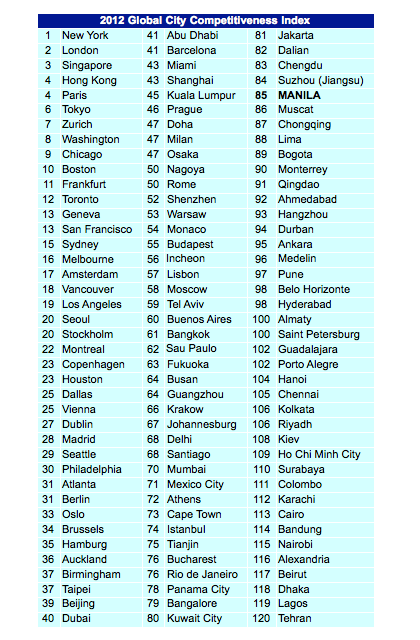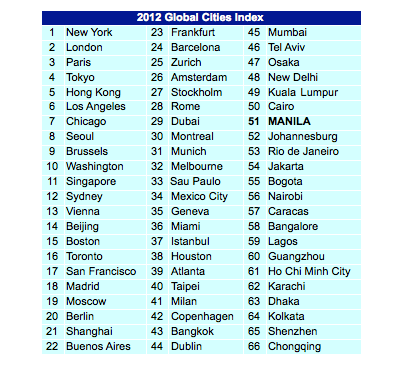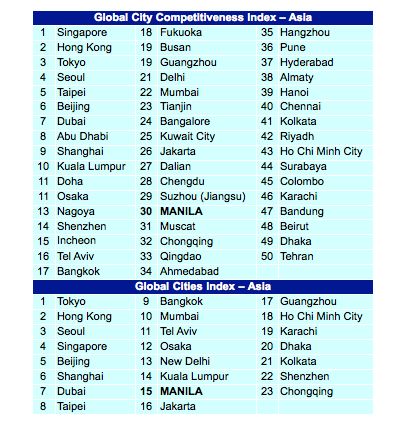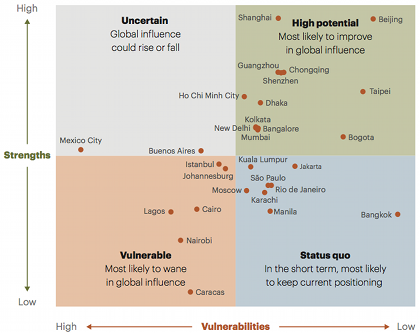SUMMARY
This is AI generated summarization, which may have errors. For context, always refer to the full article.
MANILA, Philippines – The Philippine capital has some catching up to do, as it lags behind some neighboring cities when ranked in terms of importance in the global economic system.
Manila has found itself in the bottom half of ranking in two reports, the Global City Competitiveness Index (GCCI) and Global Cities Index (GCI), both released this year. These reports rank selected cities in the world based on parameters that indicate their development.
In the GCCI, Manila ranks 85th out of 120 cities, with a score of 43.2 out of 100. New York City tops the list with a 71.4 score.
Categories for ranking cities under this report include:
- economic strength
- human capital
- institutional effectiveness
- financial maturity
- global appeal
- physical capital
- social and cultural character
- environment and natural hazards

In the GCI, on the other hand, Manila ranks 51st out of 66 cities, and gets 1.49 out of 10. Again, New York City tops the list with a far 6.35 grade.
Categories for determining the grades in this report include:
- business activity
- human capital
- information exchange
- cultural experience
- political engagement

Among Asian cities, Manila ranks 30th out of 50 cities in the GCCI, and 15th out of 23 cities in the GCI.
Neighbor cities Singapore, Hong Kong, Taipei, Bangkok, and Kuala Lumpur are ahead of Manila in both lists. Jakarta is ahead of Manila only in the GCCI.
Manila is the only Philippine city included in the lists. Other countries such as China, USA, India, and Korea have multiple cities ranked in one or both lists.
The term “global city” refers to cities that are big contributors in the global economic system. All the cities ranked in these reports collectively represent about 29% of the global economy, with a combined GDP of $20.2 trillion.
“Well over half of the world’s population now lives in cities, generating more than 80% of global GDP. Already, global business is beginning to plan strategy from a city, rather than a country, perspective,” said in the GCCI.
High in character, financial stability
Though the overall grade of Manila in the GCCI is low, the city performs well in some individual categories.
Manila got the highest mark in ‘social and cultural character’ category with 61.6, and lowest mark in ‘economic strength’ category with 34.
Manila competes well in two categories. The city ranks 60th in the ‘social and cultural character’ category, and ranks 33rd in the ‘financial stability’ category with a score of 50, tying with 27 other cities including Los Angeles, Rome, and Taipei.
Zurich, in Switzerland, tops both categories.
Emerging cities
The GCI also makes an assessment of 29 emerging global cities, which include Manila and neighboring Asean cities Kuala Lumpur, Bangkok, and Jakarta.
Each emerging global city is assessed based on their:
- strengths (gross domestic product growth, middle class growth, infrastructure improvement, and improvement in ease of doing business)
- vulnerabilities (higher pollution levels, increased insecurity and instability rates, corruption, and a deteriorating healthcare system)

All four Asean cities register low in both categories. 
“Those in the status quo quadrant (lower right) have low strength and vulnerability scores, suggesting relative stability,” the report said.
Rise of Asian cities
Unfortunately, Manila does not share the promising fate of the more fortunate Asian cities.
Most Asian cities are noted for their economic rise, as reflected in their dominance in the ‘economic strength’ category-—the most highly weighted category–of the GCCI. Three Chinese cities top the list, with Singapore (15th), Bangalore (16th), Ahmedabad (19th), Hanoi (joint 20th) and nine other Chinese cities rounding off the top 20 in this category.
“The top Asian cities are all forecast to grow by at least 5% annually between now and 2016. Twelve of them will grow by at least 10%. This is in stark contrast to the low single- digit growth of most developed market cities in Europe and the United States,” the report said.
The relevance of top Asian cities on the world stage was also noted in the GCI. “All editions of the Global Cities Index have featured at least three Asian cities in the top 10. In addition to Tokyo, other Asian cities, including Hong Kong, Seoul, Singapore, Beijing, and Shanghai, represent up-and-coming metroplexes that will further accentuate the ascendance of Asian cities,” the report said.
Among emerging global cities, Chinese and Indian cities are seen as promising. Chinese cities (like Beijing and Shanghai) “are likely to continue pushing toward a larger global presence,” while Indian cities (like Kolkata, New Delhi, Bangalore, and Mumbai) “may rise in future rankings.” – Rappler.com
Add a comment
How does this make you feel?
There are no comments yet. Add your comment to start the conversation.